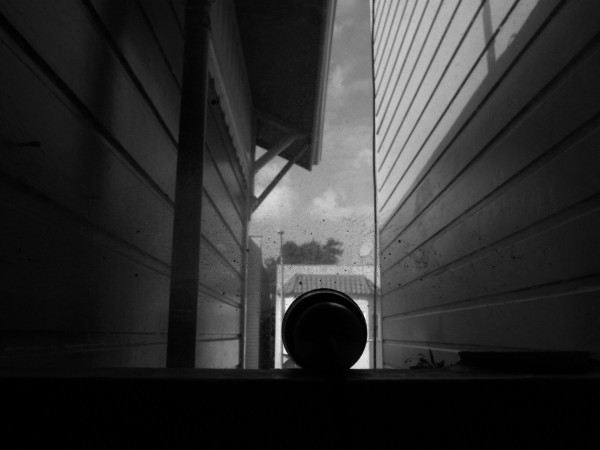Listen 來聽
Glass Panel 玻璃屏風
Listen 來聽 / Main 大觀 / Special: Sounds of “usual” life during the pandemic 抗疫「日常」的聲音
Kevin Corcoran
02:55PM, 03/27/2020
Mission District, San Francisco, California USA 美國加州三藩市教會區
05’40’’ / Sound Devices Mixpre-6 / Contact microphone on window, inductor on electronic devices, omni microphones on window 接觸式咪高峰貼於窗上,感應器置於電器上,全向式咪高峰置於窗邊
home, pandemic, traffic, USA
At home in the afternoon, day 11 of the shelter-in-place order during the pandemic. Staying home during the day I notice the difference in noise levels from the front of the apartment to the back. The recording begins with a contact microphone on the front window amplifying the vibrations of passing traffic and subtle gusts of wind on the old window frame. It shifts to a pair of omni microphones placed at the open window at the back, listening to the wind in the leaves of nearby trees, a few birds, a distant siren, and some faint sounds of neighbours’ domestic activities. Sirens are heard a few times a day – though I’m not sure if this has to do with the pandemic, or the fact that I am usually not at home during the day, and actually it is normal to hear them so often. The electronic sounds are fields of electromagnetic activity from screens of my computer and mobile phone.
Where I live is a busy street typically heavy with traffic, especially the large buses which tech companies use to shuttle their workers in and out of the city during commuting hours. While ordered to work from home these large buses do not operate, so the rumbling, idling motors which normally shake my window with such force have given way to the sounds of normal traffic – still a noisy urban environment, but not nearly as noisy as usual. The city bus still passes, though I can see from my window not many people are riding on it. The difference in the quality of sounds when listening from the front and back windows of the apartment, makes them feel like two different places entirely. From the back it sounds suburban, not in the middle of a city, as wind in the leaves and birds can be heard in much more focus than the traces of inner-city activity.
I chose to make a field recording in two senses: the field surrounding my apartment heard through windows, and the field of electromagnetic radiation surrounding the digital screens I use to connect to the world outside my apartment. Since I am living and working in the apartment during the pandemic and only leave it once a day for a short walk or to pick up some groceries at the corner market, these two types of glass panels offer outside views and ways to not feel completely isolated, to communicate with friends and family, to keep connections with the music and art communities I engage with, and to remain informed with daily updates on the state of the pandemic at home and abroad.
這是居家隔離第11天的下午。我發現日間在家中前後的聲量很不一樣。錄音的開端是我把接觸式咪高峰貼於前窗上,放大了路上交通和微風穿過舊窗框的震動。之後我把一對全向式咪高峰置於打開的後窗邊,我聽見風吹在樹葉上、一些雀鳥、遠處的警報,和鄰居家居活動的微弱聲音。警報聲一天出現不只一次,但我不確定這是否跟疫情有關還是定期正常的警報,因為我以往不會於日間時份留在家中。錄音中出現的電子聲音來自我的電腦和手提電話的電磁場。
我住在一條交通繁忙的街道上,尤其在繁忙時間,總有一些科技公司安排接送員工的大巴士出現。現在大家都在家工作,所以大巴士也暫停運作了,以往把我的窗震動的隆隆、空轉的摩打聲也消失了,只剩下毫無特色的交通聲。這裏仍然是一個嘈雜的環境,只是不及以往般嚴重。從窗口看出去,仍然有好些巴士駛過,雖然乘客已不多。家中前窗和後窗所聽到的聲音完全不同,感覺像是身處於兩個不同地方。後窗所聽到的像是郊區,而不是城市的中央;對比起城市內的活動,我可以專注聆聽風吹過樹葉和雀鳥的聲音。
我選擇作田野錄音主要有兩種考量:通過我住所的玻璃窗所聽到並包圍著我的聲音,和那些我用來跟住所以外的世界接觸的電子屏幕所發出之電磁場。現在長時間在家工作和生活,我每天只有短暫時間外出散步或到街角的市場購買日用品。家中的兩扇窗讓我看到外面的景觀,因此我沒有感覺被完全孤立,仍可以與親友交談,仍可以跟我所屬的音樂和藝術群組聯絡,以及可以在家裏一直追蹤疫情在美國和世界各地的情況。
